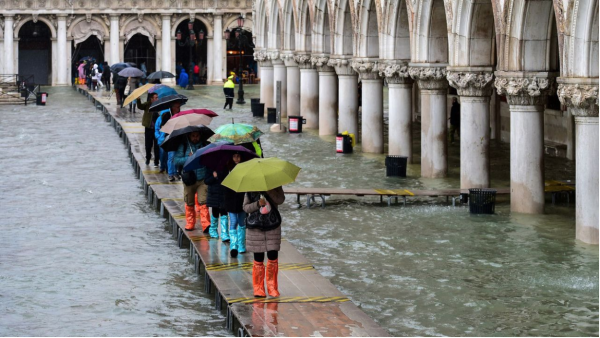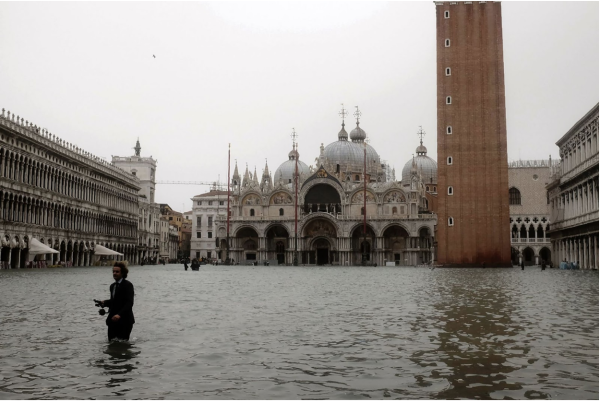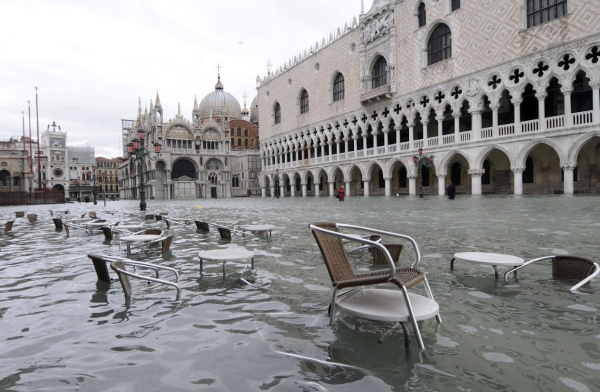The extravagant tourist city of Venice is slowly sinking. Known for its ornate architecture and rich culture, the lack of concrete streets with labyrinthian canals is what makes Venice, Italy a prime vacation spot. It has been fighting rising water levels since the fifth century. Due to both natural and man-made factors, Venice floods more than 100 times a year.
Acqua Alta is a natural phenomenon that translates to “high water” and refers to the tide peaks that occur during strong winds, high tide, and sea waves that cause more water to flow into the Venetian Lagoon. It typically happens in the winter and spring, flooding most frequently in December. Though the tide can vary depending on meteorological factors and moon phases, such as new or full moons. High tide, high winds, and seasonal rainfall cause Venice’s streets to fill with water frequently.
Elevated wooden walkways are laid out when the city floods, though locals commonly prefer knee-high rubber boots to navigate the streets. In St. Mark’s Square, the city’s lowest point and most frequently flooded area, locals place wooden benches end-to-end to create elevated sidewalks. The vast amount of people all jostle for a space on the narrow walkways, and while a solution is imminent, it is not coming fast enough.

Well, why is Venice sinking? The city’s foundations sit atop sediments deposited at Po River as well as piles of timber driven into the mud beneath the lagoon. The sediments are still compacting and settling, and the mud beneath the piles shifts over time, causing the entire city to sink slightly. Industrial practices such as construction projects, offshore piers, the railroad bridge to the mainland, and groundwater extraction of gas shifted the seafloor and tidal cycles in ways that exacerbated the sinking. The process of drawing gas and salt water from beneath the ground caused the unstable land to sink faster.
20th century industry projects pumping out tremendous amounts of groundwater from the aquifer beneath the lagoon for nearly 50 years have accelerated the sinking process. Venice has sunk almost ten inches in the last century.

The Modulo Sperimentale Elettromeccanico project (MOSE) was crafted by engineering firms in 1984, however wasn’t lifted off the ground until 2003. A series of barriers are to rise for the floor of the lagoon’s three inlets where the sea meets Venice’s lagoon. In the event of high waters, the gates will rise and prevent Venice from heavy flooding. Corruption and scandal have surrounded the project, making it difficult to continue building even though the first gates have already been installed. Combined with the costs of the project being worth four billion, and technical challenges, the project is expected to reach completion in 2025. On top of the MOSE project, crews are also cleaning up over a century’s worth of muck and rubble to slowly improve the infrastructure of the historic buildings, bridges, and fountains. They are working to rebuild and waterproof canal sidings as well.
While these solutions are not permanent, they will grant us another hundred years while we try to find other alternatives. Experts at the National Institute of Geophysics and Volcanology (INGV) estimate that parts of Venice will be submerged by 2150, only visible at its highest points. The data is based on statistics collected over the last 20 years by Venice’s tidal center. The west side of the city will be one of the first affected as it is one of the most frequently flooded areas, going underwater 58 times between 2019 and 2023.

Environmental scientists from the University of Padua, Italy are pushing for greater protection of the salt marshes in the lagoon as they are crucial flood protection. The Po Delta covers around 500 km2 of northeast Italy. These marshes act as buffers to naturally shield the city from high tides and high winds.
Click here to read more about the natural risk offshore drilling causes.














